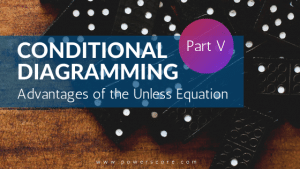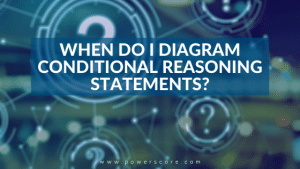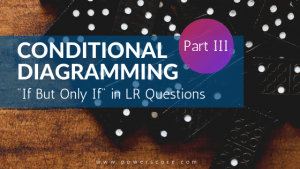Many students, upon being introduced to the foundational concepts of conditional reasoning and deductive logic, begin to "see" conditionality everywhere. In a sense, it is everywhere - especially in deductive reasoning, which forms the basis for most LSAT questions. You may even find comfort in the rule-driven environment of formal, or deductive, logic. There is nothing wrong with that, per se. But you need to know when you've gone far. To … [Read more...]
Conditional Diagramming Part V: Advantages of the Unless Equation
Students often ask if there is an easier way to handle conditional statements containing necessary condition indicators such as “unless,” “except,” “until,” and “without.” The Unless EquationTM This is relatively simple, but it does involve a two-step process:Whatever term is modified by “unless” becomes the necessary condition. The remaining term is negated and becomes the sufficient condition.For example, consider the … [Read more...]
Conditional Diagramming Part IV: Working with “Only”
We are continuing our Conditional Diagramming discussion today with the word “only” which is used frequently in LSAT questions. “Only” is a necessary condition indicator, and its usage is often easy to parse. Here’s an example: Only doctors carry malpractice insurance. “Only” modifies “doctors,” and thus the proper diagram is: Carry malpractice insurance → doctor However, in a number of instances, “only” is used in a way that is more … [Read more...]
When Do I Diagram Conditional Reasoning Statements?
A question that frequently comes up from readers of the LSAT Logical Reasoning Bible is, when should I diagram conditional statements in the LSAT Logical Reasoning section? In the book, I talk about diagramming in a number of different chapters, but most prominently in the chapter on Conditional Reasoning.Conditional Reasoning is a Major Concept While, not surprisingly, I think that every chapter in the LR Bible has high value, the … [Read more...]
Unusual Rules in LSAT Logic Games: It’s the New Norm
Confusing Rules If you’ve taken any test from the last couple of years, you may have stumbled upon strangely-worded or confusing rules. For example: Train A can arrive earlier than train B if and only if train B arrives earlier than train C. Either car A arrives immediately before car B, or it arrives immediately after car C, but not both. The Q meal is served at some time after either the M meal or the N meal, but not after both. It’s worth … [Read more...]
When Does “Either/Or” Mean “Both” on the LSAT?
Understanding the proper conditional relationship represented by the “either/or” conjunction in LSAT questions is crucial in both Logic Games and Logical Reasoning questions. While there are some solid rules you must follow, ultimately you should take into account the context in which the phrase is used. Learning the Rules Typically, a rule such as “either A or B must be selected” is inclusive. It allows for the possibility of selecting both A … [Read more...]
Conditional Diagramming Part II: “And” in the Necessary Condition
In my last post, I discussed conditional statements with "or" in the sufficient condition. Diagrams with multiple necessary conditions can, depending on the circumstances, then be used to create multiple single diagrams. Let's look at an example.If the rule reads: "If Operations is offered, then Accounting or Sales is also offered," then the diagram is solely: A O → or S Because the necessary condition is just at least … [Read more...]
Conditional Diagramming Part I: “Or” in the Sufficient Condition
Diagrams with multiple sufficient conditions can, depending on the circumstances, then be used to create multiple single diagrams. Let's look at an example.Consider a rule that reads: "If Operations or Sales is offered, then Accounting is also offered." Operations = O Sales = S Accounting = A As a single conditional statement, there are two parts to the sufficient condition (O and S), that are joined by an "or" operator. That sufficient … [Read more...]
Conditional Diagramming Part III: “If But Only If” in LR Questions
An interesting topic came up on our forum a short time back, about the meaning of “If but only if,” and the proper way to diagram a rule that includes this phrase. Students who are familiar with the LSAT have probably encountered a rule that says “if and only if,” but the use of the term “but” is a clever trick by the test makers. “If but only if” doesn’t look quite the same as “If and only if,” and to many students, the two phrases appear to … [Read more...]









